Are You Reaching the Right Consumers?
In healthcare marketing, success isn’t just about generating leads—it’s about generating the right leads. Yet many organizations struggle with poor lead quality, filling the pipeline with patients who are not the right fit. This leads to wasted marketing spend, lower conversion rates, and frustration for both providers and patients.
Table of Contents
In healthcare, the harsh reality is that no single organization can help everybody. I’d like to take that notion a step further. No single healthcare organization should help everybody. Why? Because every healthcare journey is a little bit different. And if it’s not a good fit, neither the patient nor the healthcare organization will arrive at the best outcome.
Unfortunately, many healthcare organizations are great at reaching a lot of the wrong people. One reason that I’d like to address head-on is poor lead quality. I see it all the time: the marketing team puts a high volume of leads into the pipeline, but the quality is poor. It’s not a fit. As a result, those patients aren’t converting into booked appointments. This, in turn, costs the organization time and money.
That goes double for mental healthcare, addiction treatment, aesthetic and plastic surgery, or any other healthcare with similarly heavy consideration before a purchase decision. If it’s already tough to get the right patients to commit, you’re never going to meet your goals chasing the wrong people.
Your best option, therefore, is to make sure you’re reaching the right people.
How To Reach The Right People
The first step, as always, is recognizing that the problem exists. Looking at key metrics and data points like CVR and booking rates will help you evaluate whether you’re not reaching the right people currently. Once you’ve identified the problem, you can put together a strategy to solve it by defining your ideal patient and figuring out how your unique selling proposition aligns with their needs.
From there, you can dive into the nuts and bolts of leveraging the data you have to achieve the results you want. Expect to do a lot of testing to figure out the most effective marketing tactics to reach your ideal audience. Beyond your marketing strategy, there’s typically plenty of room for improving the patient experience and removing any remaining barriers between you and your ideal patients.
That’s a concise summary of the 5-step process for reaching the right people, but of course, the devil is in the details—so here are the details.
1) Identify The Problem
Evaluate the Leads You’re Already Creating
“Measurement is the path to understanding,” a Very Wise Person once said. You need to examine your existing lead data to see where the good leads come from and where there’s room for improvement. The data should show you what good and bad leads search for and the steps they take along the journey. It will show you where leads come from, too (PPC, Facebook Ads, organic search, and so on).
As you parse the data, look for trends that might indicate an opportunity for improvement. You’re looking for those a-ha moments in the journey where you say, “Ah, THAT’S why so many of our surgery leads don’t convert—they need more information on post-surgery rehabilitation care.” To that end, a few important metrics ought to provide some clues:
- Click-through rate (CTR)
- Conversion rate (CVR)
- Call to booking CVR
Know How to Spot the Signs of Suffering Lead Quality
As part of your evaluation, you’ll want to look for the common signs and causes of poor lead quality. The three most common causes that we see are:
Mismatch between what the lead wants and what you offer
How well do you know your ideal customers and what they want? If you’re not meeting their needs and intent at each stage, your lead-generation metrics will suffer.
Messaging either over promises or inaccurately describes your solution
Expectations are everything. If a lead enters your pipeline expecting to consult with a surgeon but can’t get an appointment for six months, you might have a problem. Or your website says you offer a service that you really don’t.
Messaging doesn’t provide enough detail about your solution
One common example is the healthcare provider that doesn’t offer insurance information on their website. What happens when leads come in that may need a different type of insurance or payment option? Insurance is a widespread objection.
Understand How HIPAA Limits Your Options
Healthcare marketing comes with one big challenge: HIPAA’s tight grip on privacy.
HIPAA compliance has become increasingly complex over the past two years as evolving privacy regulations have raised the stakes for healthcare marketers. With new clarifications and legal challenges reshaping the landscape, organizations must now navigate tighter restrictions while facing heightened scrutiny. These recent shifts demand a deeper understanding of the boundaries between marketing strategies and patient privacy, making compliance more crucial—and challenging—than ever before.
In December 2022, the Department of Health and Human Services (HHS) released a bulletin that tightened regulations on how healthcare information is shared. The bulletin stated that regulated entities cannot use tracking technologies if doing so would result in unauthorized disclosures of protected health information (PHI).
Tracking technologies include scripts or codes on websites or apps that collect user data through cookies, web beacons, tracking pixels, session replay scripts, and fingerprinting tools. However, this definition has faced legal challenges. On January 5, 2024, the American Hospital Association (AHA) and other organizations filed a lawsuit claiming that an IP address combined with a visit to a specific health-related webpage doesn’t qualify as PHI.
On June 20, 2024, the court ruled that the Office for Civil Rights (OCR) overstepped its authority by trying to regulate this “Proscribed Combination.” While the ruling leaves other HIPAA rules intact, it remains uncertain how aggressively the OCR will push for stricter enforcement in this area.
With the regulatory landscape still unclear and the threat of class action lawsuits remaining, healthcare organizations must assess their risk tolerance when developing digital marketing strategies. We recommend healthcare providers consult with their legal and compliance teams and make sure their marketing strategy adheres to the latest privacy rules. This not only helps protect you from lawsuits but also meets the privacy expectations of today’s consumers.
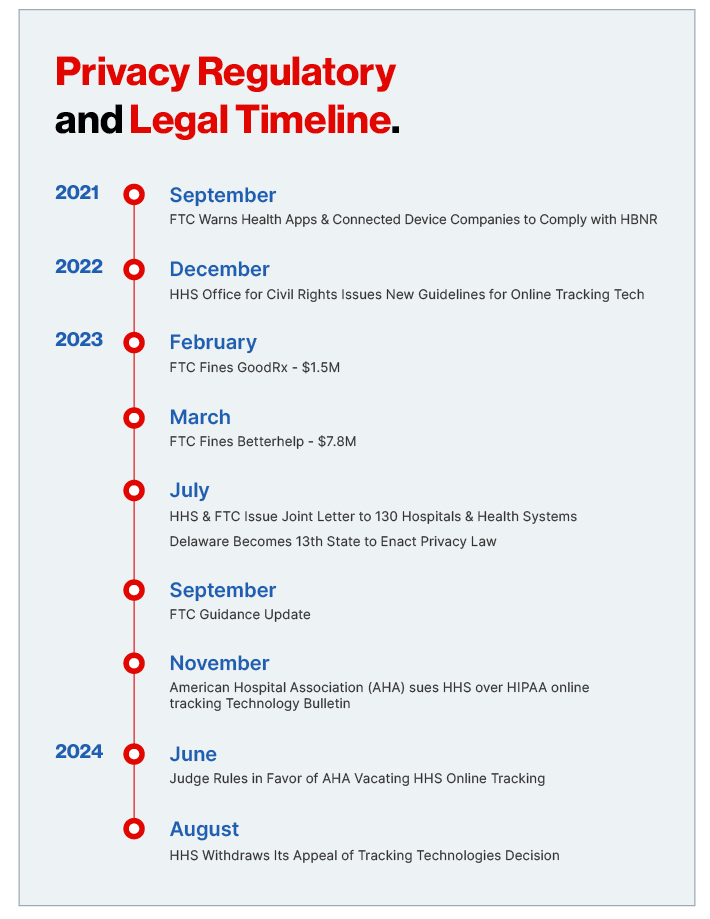
2) Define Your Goals, Position, & Audience
Research the Ideal Patient
Your ideal patients are looking for you. But if you want them to find you, you need to understand who they are as a whole person. Knowing some keywords they use is a good first step, but focusing too narrowly on specific keywords will limit your ability to reach your ideal patients. By considering them as whole people and understanding what makes them an ideal fit, you’ll be able to shift your perspective and find new tactics for reaching the audience you want to reach.
To do that, you’ll need to leverage your available data to put together a more comprehensive ideal patient profile and persona. You can analyze everything from on-site usage metrics and usability testing data to intake data and exit interviews to user geodata. You may also want to send out surveys to gather additional data.
Once you have crunched all that data, you’ll be able to build an ideal patient persona, which you can then target for further research by interviewing patients or potential patients who fit the profile, as well as doing some competitive analysis to understand what approach others in the market are taking.

By gaining a fuller understanding of your ideal patients and who they are, you’ll be better positioned to devise new methods of reaching them. That will allow you to develop campaigns more likely to reach your ideal patient by considering things like:
- Clinical Suitability: Target by diagnosis, provider visits, prescriptions, etc.
- Financial Qualifications: Household income targeting, Payor targeting, etc.
- Warm Audiences: Reaching the decision maker, Household-level targeting to reach parents, etc.
Gain Stronger Marketing – Ops Alignment
Marketing needs to be in conversation with operations to understand exactly who your ads need to be reaching and adjust accordingly. Focusing purely on lead volume without optimizing for quality leads results in a high volume of disqualified leads —especially in verticals like behavioral, where leads are frequently disqualified for a variety of reasons from age requirements to insurance.
Aligning with operations to understand why leads are disqualified will help you understand what a qualified lead looks like—and let you feed better signals to platforms like Google Ads to refine your media strategy.
There’s no giant bucket labeled “ideal patients.” Well, maybe if your 3-year-old daughter wants to play doctor, then everyone’s an ideal patient. However, for actual healthcare organizations, what makes an ideal patient is nuanced and will vary based on vertical, service lines, market, and provider groups. So you can’t just grab someone else’s ideal patients; you need YOUR ideal patients, and that means strong alignment with operations around defining your ideal patient profile. That’s how you’re going to improve lead quality and drive more new appointments.
Related: Read Marketing + Operations: Why Total Alignment is Vital to Growth to learn how to gain alignment around ideal patient, service line priorities, messaging, technology, and practice capacity.
Define Your Unique Selling Proposition (USP)
In How to Define Your USP and Improve Your Healthcare Marketing, I go into great detail on the importance of a crystallized USP. The strength and specificity of your USP will differentiate you in crowded and competitive markets. It can help improve lead quality by engaging and persuading your ideal patient.
To define your USP, you can use many of the same avenues you use for keyword and customer research. Generally, think about the unique capabilities or services that you offer. Special equipment or technology? Training, experience, or credentials? What about your patient experience? These are common differentiators for healthcare providers.
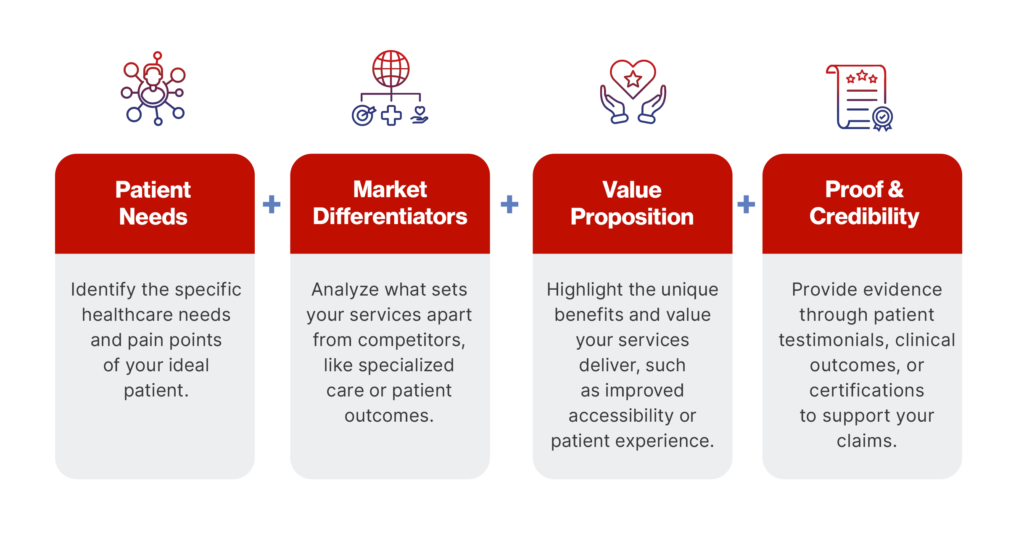
Understand Your Marketing Maturity Level
Another important strategic consideration is to understand how mature your marketing is currently, so you can build a roadmap for getting from where you are now to where you want to be. This is going to differ based on your current Martech stack, integrations, brand architecture, performance of existing channels, core marketing tactics, key metrics, etc.
For example, if all of your tracking relied on pixels and other PHI trackers that are now in violation of HIPAA and you haven’t found a good replacement option yet, you’re still at the earliest stages of marketing maturity, and your immediate goal should be to implement some compliant tracking options so you have data to pass to Google Ads and SEO.
If your marketing is a bit more mature and you’re using that data to advertise on Google Ads, but still not maxing out impression share, then you want to focus on optimizing your current demand capture before you start expanding into new channels like Meta.

Each stage of marketing maturity builds the foundation for the next stage. So, you need to know where you are now to know what you should do next. You don’t want to worry about diversifying your media mix and expanding into demand generation before you maximize the demand capture campaigns you already have running. You can’t maximize your demand capture campaigns if you don’t have basic tracking data to pass to the ad platforms in the first place.
So take the time to look at where you are now.
- Do you have an integrated tech stack across brands?
- Are you still only tracking clicks, or are you able to track booked appointments?
- Is conversion data being passed back to the ad platforms?
- Are marketing platforms connected to your PMS? Can you determine ROAS?
The draw to diversify your media mix can be strong, but first, you need to build a solid martech foundation.
Your roadmap for moving your marketing forward should start with taking care of the low-hanging fruit at your current stage because that’s how you’ll put yourself in a much better position to get your marketing to where you want it to be. Once you’ve laid out your strategic roadmap, then you can better understand where your focus needs to be on a tactical level.
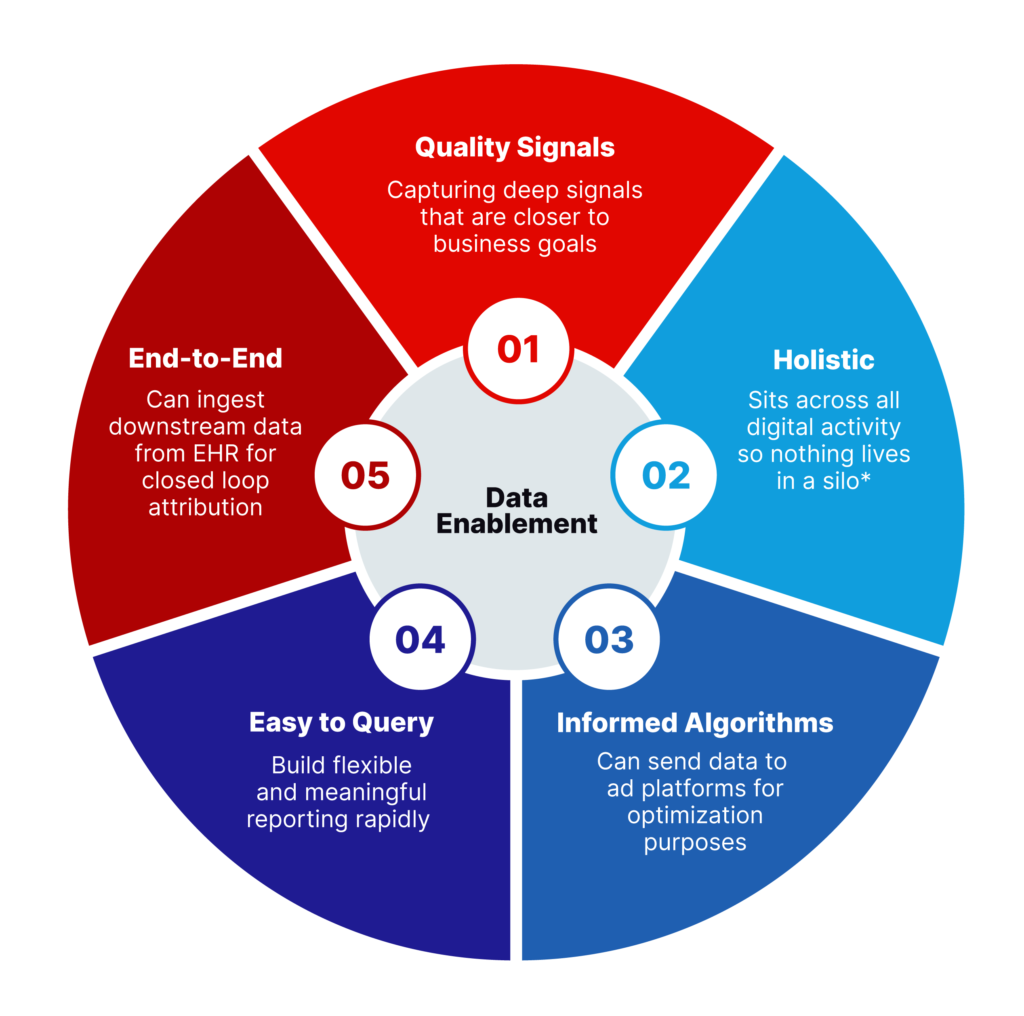
3) Implement Advanced Media Tactics
To truly elevate lead quality, it’s essential to focus on tactical execution. Now that you’ve aligned your brand and strategy with what your ideal patients need, the next step is deploying targeted tactics that fine-tune your audience targeting and lead quality. From tracking calls to better understand patient interactions to optimizing Google Ads bidding strategies and using advanced tactics like third-party claims data and geofencing, these methods allow for smarter decision-making, ensuring your focus stays on the highest-quality leads.
Train the Algorithms with Conversion Signals
Not all leads are equal. A campaign that looks successful on paper—filled with clicks and form submissions—may not translate into actual patient bookings.
Digital ad platforms like Google Ads and Meta Ads rely on conversion signals—key data points that indicate valuable actions like booked appointments. These signals guide machine learning algorithms, improving lead quality and campaign efficiency.
2 Reasons High-quality Converion Signals Matter:
- Lead Quality Over Quantity: Prioritizing booked appointments over surface-level interactions (e.g., clicks, page visits, downloads) improves patient acquisition.
- Optimized Bidding Strategies: Feeding platforms the right signals enhances Target CPA and ROAS strategies, leading to better budget allocation.
How to Train the Algorithm with Better Data
To improve ad performance and conversion rates, implement:
- Offline Conversion Tracking: Send anonymized booked appointment data back to ad platforms to refine targeting.
- Privacy-Compliant Data Tools: Platforms like Freshpaint securely pass conversion data while maintaining HIPAA compliance.
- Booking System Integrations: Sync tools like NextHealth with Google Ads to optimize for real patient conversions, not just interactions.
Implement Call and Lead Tracking Software
Not all phone calls are created equal either. A patient scheduling an appointment is far more valuable than someone asking for directions—but without call tracking, ad platforms won’t know the difference.
Phone calls are inherently nebulous and difficult to measure in terms of quality. Manual call analysis is time-consuming and lacks real-time optimization. You also can’t send manual analysis notes back to the algorithms used in advertising to optimize toward qualified calls.
That’s why we recommend HIPAA-compliant call and lead tracking solutions that classify and analyze calls in real time, helping optimize campaigns for actual patient conversions. Our clients’ top pick?
By integrating these tools, you can:
✔ Track and categorize calls by intent (appointments vs. inquiries).
✔ Filter out unqualified leads before they enter your pipeline.
✔ Send conversion data back to Google Ads and other platforms to improve campaign targeting.
The result? More high-value patient leads, better budget allocation, and smarter algorithm training. Call tracking isn’t just an optimization tool—it’s a must-have for precision in patient acquisition.
Top Benefits of HIPAA-compliant Call Tracking:
-
- Optimize marketing efforts to conversions while staying compliant
- Avoid data loss after tracking pixels are removed
- Send offline data (e.g., calls) to analytic platforms for better attribution
- Enable full-funnel measurement
- Enrich anonymous users with attributes like gender, age, and service needs
Apply Call Insights
If you use a paid call tracking solution, you can filter out unqualified calls from the ad platform. This will train the algorithm to chase conversions based on criteria that you define—instead of Google.
To refine call quality:
- Set a time threshold: Only pass calls 60 seconds or longer to the platform (longer for certain healthcare specialties).
- Tag and score calls: Analyze call content to identify patterns in qualified vs. unqualified leads.
- Filter out low-value calls: Exclude calls unrelated to patient acquisition, such as billing inquiries, cancellations, or directions.
By prioritizing calls that lead to booked appointments, you send stronger signals to ad platforms, improving bidding efficiency. If too many calls are unqualified, consider removing call extensions from campaigns to reduce wasted spend.
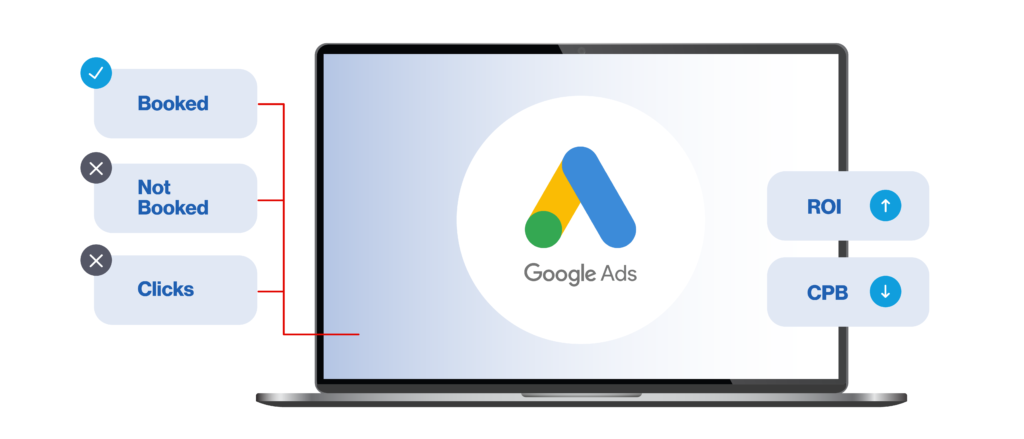
Use Value-based Bidding
Not all conversions are valued the same, and you must ensure that Google Ads understands these nuances in quality.
Target CPA bidding does not take quality into account; it attempts to source the lowest-cost conversions first and then expands to higher-cost conversions. This often leads to the majority of conversions coming from calls versus from the website or form submissions.
Value-based bidding tells Google what you consider to be the most and least valuable conversion actions. For example, perhaps online bookings are routinely disqualified due to diagnosis mismatch, or leads generated from social media convert into loyal patients with a higher lifetime value.
In order for the algorithm to respect the values that you set, campaigns must use either Maximize Conversion Value of Target ROAS. After values are assigned to conversion actions, you’ll want to wait approximately six weeks before switching campaigns to a value-based bidding strategy. This will give campaigns a smoother transition as Google Ads learns which conversions are most valuable.

Assign Values to Conversion Actions to Prioritize Different Conversion Types
When there are known differences in the lead-to-sale rate across different conversion types, assign conversion values to conversion actions appropriately. For example, if it is known that the value of an acquisition is $1,000 and 20% of calls become patients while 40% of forms become patients, forms are worth twice each call, and you can assign conversion values appropriately for both calls and forms.
After assigning conversion actions, you should switch to value-based bidding using either Maximize Conversion Value or Target ROAS. These bidding strategies will ensure that the algorithm respects the values you determined for each conversion action.
Leverage New 3rd Party Data Sources in Full-Funnel Strategy
When your ideal audience is a specific niche, 3rd party data sources like Purple Labs or Definitive Healthcare are a great way to access claims and referral data for advanced targeting and audience building. By making use of their specific codes for various procedures, prescriptions, and diagnoses, you can hone in on a narrowly defined audience of your ideal clients based on attributes such as:
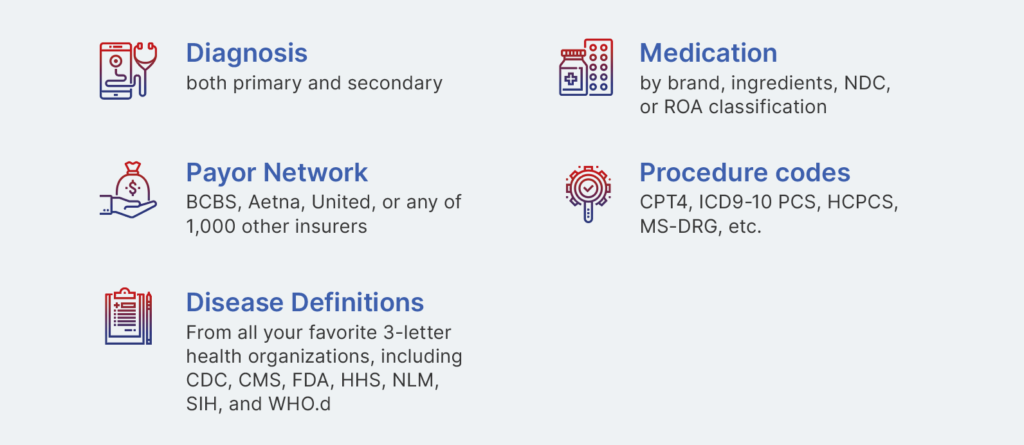
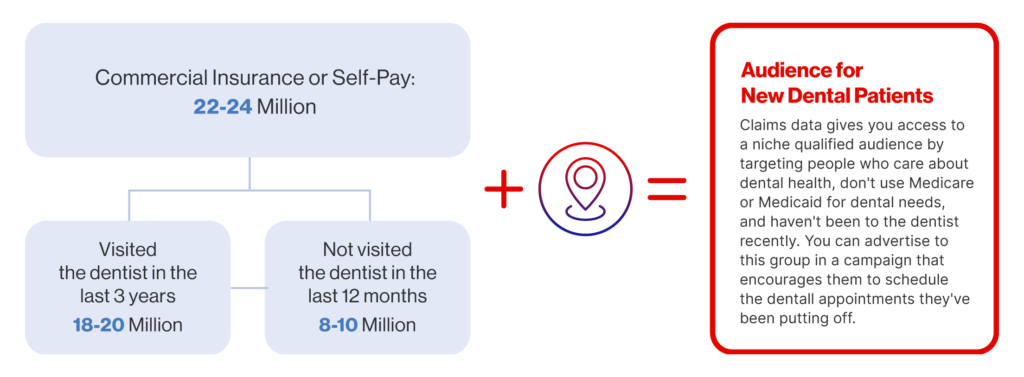
By making good use of the above attributes to further refine your targeting, you can create highly customized audiences in programmatic display networks like Meta, Illumin, and StackAdapt as part of your full-funnel strategy.
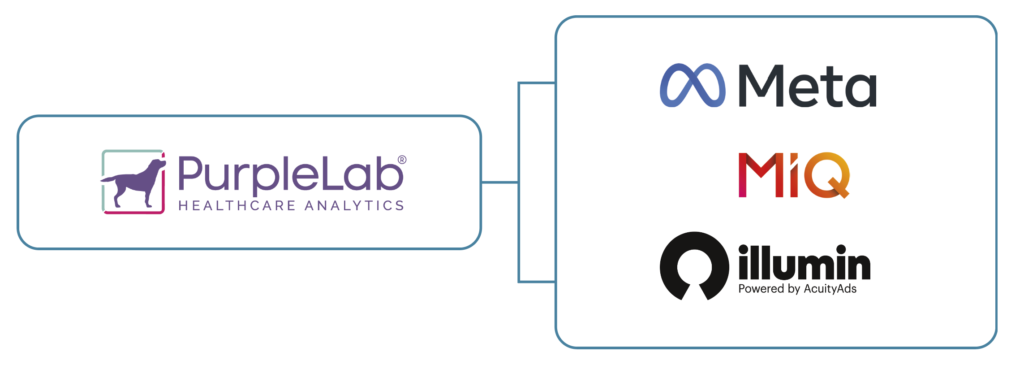
Why Are 3rd Party Data Sources Important?
It’s hard to overstate the value of unlocking payor-based strategies by leveraging 3rd party data sources like PurpleLabs and Definitive. Many organizations find that even though their search campaign is driving a decent number of leads, the quality of those leads isn’t as high as they’d like. Leads can be disqualified for various reasons, such as:
- No diagnosis
- Not clinically suitable
- Lack of insurance or insurance not accepted
The benefit of 3rd party data is the ability to take a much more sophisticated approach to reach an audience that has the right plans and the right payors, in addition to the right diagnosis. By digging into the data and focusing on those highest-value prospective patients, taking reimbursement rates into consideration, you can greatly improve the efficiency of your leads.
For example, imagine that you’re an Applied Behavior Analysis (ABA) therapy provider with specific client qualification needs. You only serve children ages 3-6, and they must have an autism spectrum disorder (ASD) diagnosis.
With 3rd party data sources, you can ensure you’re specifically targeting parents of children who have been diagnosed with ASD. You can also layer on Blue Cross Blue Shield (BCBS) as a payor network if you want to ensure the audience you’re targeting has a health plan with ABA therapy coverage.
While there’s no limit to how many leads you can get if you spend infinite money, most of us are doing marketing with a finite budget, and so we want to maximize our return on investment. Lowering cost per lead is part of that equation, but improving lead quality may be even more important and is too often overlooked because it’s not a single dollar figure. By reaching out to the right audience, you can make sure your marketing is as effective as it can be in driving revenue for the organization.
Refine Negative Keyword Lists
A key part of reaching the right patients is not wasting money on reaching out to the wrong patients, and that’s where refining your negative keyword list can help you hone in on your ideal clients. Without a good negative keyword strategy, you’re going to end up serving ads to a lot of irrelevant queries—doubly so if you’re using Google’s default broad matching.
MOPS alignment is crucial for building a negative keyword list, having those conversations with ops to understand not only the ideal client profile but also what are the most common factors in poor-quality leads. Ideally, you want to use negative keywords to filter out those customers before you waste money advertising to them and waste time disqualifying them further down the funnel.
Negative keywords will prevent your ads from being shown to people who search for the terms you define as negative. For example, if you are a dentistry practice that does not sell safe sex supplies, you might want to appear in searches for “dental repair” but have a negative keyword for the phrase “dental dam.” 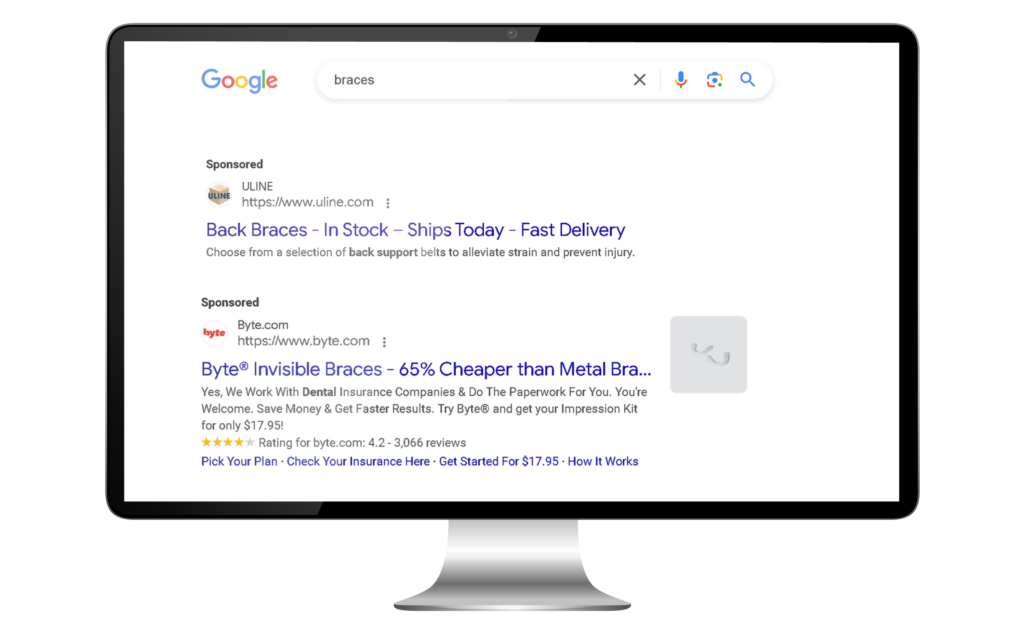
There is some flexibility in negative keywords, allowing you to choose how wide a net you wish to cast around the key phrases to avoid:
- Broad match negative keywords will keep your ads away from any searches that contain the keywords in any order, useful if you want to avoid an entire category of searches.
- Phrase match negative keywords will only stop ads for searches with the designated keywords in that order, so a negative phrase match for “free dental” will keep your ad from showing up when someone searches “Free dental cleanings”, but it may still appear when someone searches “dental cleanings for free”.
- Exact match negative keywords only stop the exact keyword phrase with no additional words, useful when you want to avoid a very specific search string.
Assembling a negative keyword list can be just as difficult as assembling a positive keyword list. And like positive keywords, your negative lists will include different keywords aimed at different parts of the funnel. Ask yourself (and your operations team and your call tracking data) what most frequently disqualifies a lead at each step of the way. And don’t be afraid to think outside the box— e.g., if you’re targeting a certain regional or age demographic, you can use negative keywords to remove searches common to the groups you’re trying to avoid.
Geofence with 3P Data Sources
The more you understand about your ideal client profile, the more ways you can target your marketing to reach them. This is when you want to dig deep into your data and find out what your ideal clients have in common:
- Who do they work for?
- Where do they shop?
- What type of insurance do they have?
These are all questions to which the answers can be combined with available demographic targeting to reach more qualified audiences. Insurance can be an especially useful data point to consider, not only because insurance that covers your service is something that makes leads much more likely to convert, but because insurance type can be relatively easy to target with 3rd party platforms.
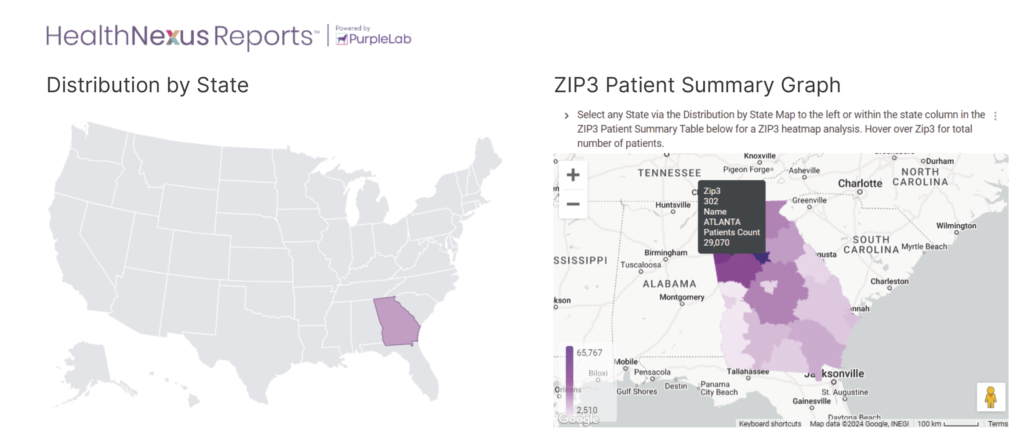
We saw this with a client who wanted to reach more patients who had dental coverage that’s standard through Blue Cross Blue Shield (BCBS). We used Stack Adapt to target BCBS buyers directly, and then we made use of geofencing around federal buildings to tap into the federal insurance health benefits that include BCBS. We also used location-based audiences with a 7-day look-back window for offices with BCBS-covered employees.
The result of all this geofencing? A campaign designed specifically to reach the people whose BCBS insurance would cover their dental work and a much higher conversion rate than previous campaigns. The ability to use geofencing to get very specific about the types of clients you want to reach is a powerful tool that you should leverage.
Test New Ad Units & Features
Facebook’s Instant Form Feature
Once you’ve hit the wall in terms of demand capture, the next step is expanding into full-funnel advertising that uses social media to build brand awareness. This lets you generate new demand by reaching users who are interested but not actively searching. Social ads can be a valuable tool, but targeting is no longer perfectly precise, as HIPAA and other privacy regulations have limited how much information you get upfront about each user.
The solution? Facebook’s Instant Lead Forms let you immediately ask the questions that will qualify or disqualify your leads right in the platform people are using. These forms are robust, allowing for custom questions, conditional logic, and gated content. This allows you to build authority by sharing educational content with consumers who have healthcare concerns.
Instant forms can also be sent directly to users who have shown interest in interacting with your video campaign. By retargeting users who have already engaged with video, and then using Instant forms to qualify leads and generate referrals, we’ve seen organizations lower cost per referral by ~40%, putting social at a comparable level with search campaigns targeting bottom-of-funnel keywords.

Enhanced Conditional Logic – Lead Forms
Perhaps the best feature of Facebook’s instant forms is their ability to employ conditional logic, which shows users different pages or questions depending on how they answered the previous question. This prevents users who are disqualified from reaching the final stage of lead form submission, ensuring that the leads you capture through social media are of high quality.
Enhanced lead forms allow you to filter out unqualified candidates, which is essential for specialties like ABA therapy with narrow ideal patient profiles. You can ask whether the client is in the preferred age range or has the appropriate diagnosis, and then unqualified clients can be directed to a page that explains why you aren’t the correct provider for them. You can even use enhanced lead forms to disqualify based on insurance coverage, as in this example:
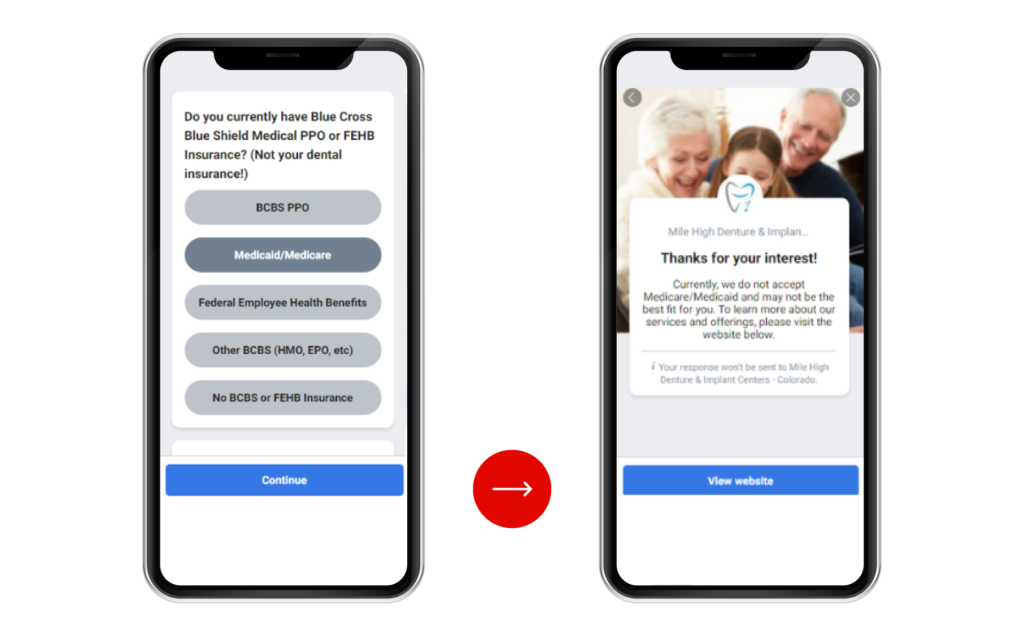
Invest in Ad Creative & Promote Your USP
Your healthcare organization can’t be all things to all people, so you need good ad creative promoting your USP to your ideal client base. Generic digital healthcare ads may be common, but they’re not cost-effective, and they drive poor lead quality. It’s not hard to understand why: If you don’t explain what you do, you’re going to get a lot of clicks from people who then realize you don’t offer what they’re looking for. Worse yet, the people who *are* looking for what you offer will never click in the first place, because you haven’t made it clear that they’re your ideal patient.
That’s why it’s important to have strong ad creative that embodies your USP and differentiates you from the wallpaper of generic digital ads. Find engaging ways to put your key message forward with engaging copywriting, compelling graphics, and linked marketing assets like blog posts and testimonials that show your value to your ideal customer.
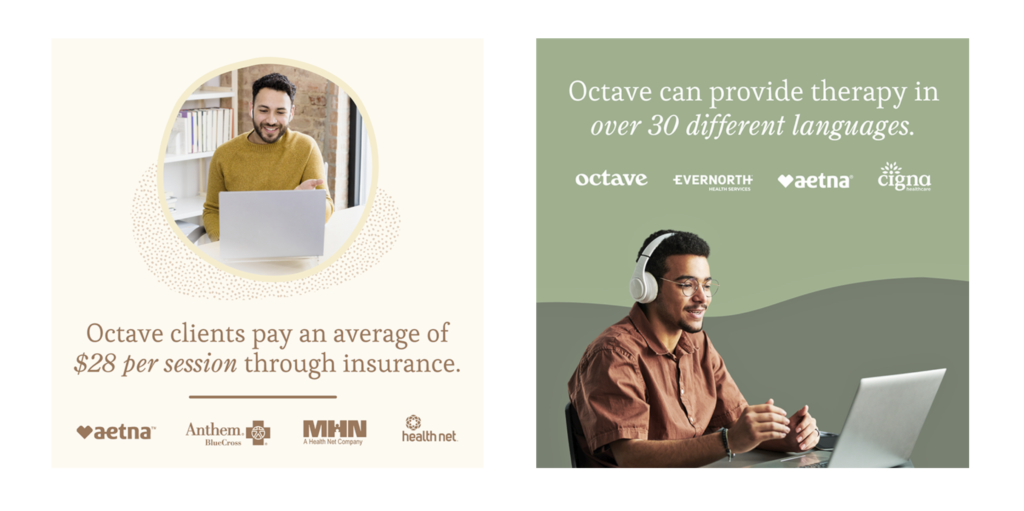
4) Test & Refine
No matter how insightful you think your strategy is or how effective a certain tactical approach may be in general, the only way to know what will help YOUR organization reach the right patients is through rigorous testing. And ideally, you want to do that testing before launching changes across your entire system. A round of early testing can offer valuable insights that will help guide further deployment and investment decisions.
So, how do you decide what to test?
We use an evaluation strategy that I think is pretty cool, so cool it’s actually ICE. That stands for Impact, Confidence, and Ease, the three factors we consider when determining which ideas to prioritize.
- Impact: How well will this product or change help reach our business goal? How much of an impact will the feature make on our target KPI?
- Confidence: How confident are we that the test will have the impact we desire? What do the action plans look like for each anticipated outcome? What would be the negative impact if the test does not result in positive outcomes?
- Ease: What resources will be allocated to this test? Is the allocation worth the investment, given the anticipated impact?
Example: Applying ICE to Media Testing
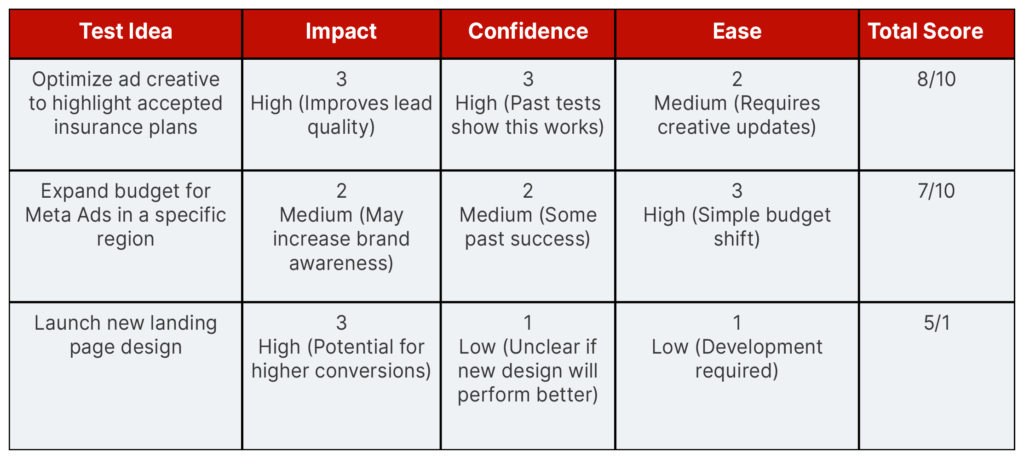
There’s never any shortage of possibilities you could test, so it’s important to focus on the ones that will make the biggest impact and fill a big need, the ones that are most likely to actually achieve their desired results, and the ones that can be implemented with minimal friction.
Testing Ideas to Consider:
While every organization is different, here are a few ideas to help jumpstart your testing strategy:
Channel Testing:
- Does PMAX drive incremental patient volume, or does it cannibalize existing search traffic?
- Do LSA leads convert into booked appointments at a higher or lower rate than Google Search Ads?
- How does expanding into Meta impact bottom-of-funnel conversions?
Website & Landing Page Optimization
- Are your forms optimized for ease of completion on mobile?
- Do users drop off at a certain step in the booking process? What happens if you remove a step?
- Is testing different CTAs (e.g., “Schedule Now” vs. “See Available Appointments”) leading to better conversions?
Ad Creative & Messaging
- Which value propositions resonate most with your target audience?
- Are certain ad formats (video, carousel, static images) outperforming others?
- How do video ads vs. static image ads compare in terms of engagement?
Scaling Tests Across Your System
Once a test proves successful, it’s time to scale it efficiently:
✔ Expand it across more campaigns or locations while maintaining performance tracking.
✔ Monitor for diminishing returns—what works at a small scale may need adjustments as you expand.
✔ Continue iterating—optimization never stops, even with proven strategies.
Testing isn’t a one-time task—it’s a continuous process of optimization. Even when you find a winning formula, consumer behavior, competitive landscapes, and regulatory factors will shift. The best-performing healthcare marketers are the ones who embrace testing as an ongoing discipline, using real patient data to refine and perfect their approach.
Thinking About Expanding Your Channel Mix?
Before investing in new advertising channels, make sure your expansion strategy is data-driven and results-focused. Learn more about testing new channel expansions: When & How to Expand Your Healthcare Media Mix.
5) Optimize the Patient Experience
Follow Up on Leads to Convert More Leads into Patients
You can improve lead quality considerably by focusing your efforts on lead generation. But no matter how “quality” a lead may seem, the true measure of a lead’s value is whether it converts into a booked appointment. Sometimes quality leads may come in through form-fills or calls but then fail to convert due to friction in the intake process or follow-up from practice operations.
To that end, the intake process should be monitored in terms of the volume of calls coming in, as well as the quality of follow-up. You might find that messages and calls aren’t getting returned due to staff shortages or a broken process. I’ve seen situations where leads just get lost in the CRM because they’re not tagged properly. As leads advance through the funnel, it’s so important to track progress using your CRM system.
Then there is your lead nurturing. As they say, out of sight, out of mind, especially for healthcare decisions that take a long time (plastic surgery, for example). This is why you need to nurture leads with routine communication. At the very least, new leads ought to be put into bucketed nurture sequences (email or text) that keep your solution top of mind.
At the end of the day, Google Ads and PPC benchmarks only tell one part of the patient acquisition story. In order to acquire a new patient successfully, you need to deliver a good patient experience and a seamless intake process. For that reason, the root of patient acquisition issues is not actually your Google Ads campaigns but rather the post-click experience your patients go through.
To address that post-click experience, here are a few areas you should audit and optimize:
Streamline Your Online Booking Experience
An important question: Just how easy is it for your patients to book an appointment? Does it take 3 steps or 20? If your answer is closer to the latter, you have an issue. Today’s patients want an effortless booking experience similar to the ones they are now experiencing in retail.
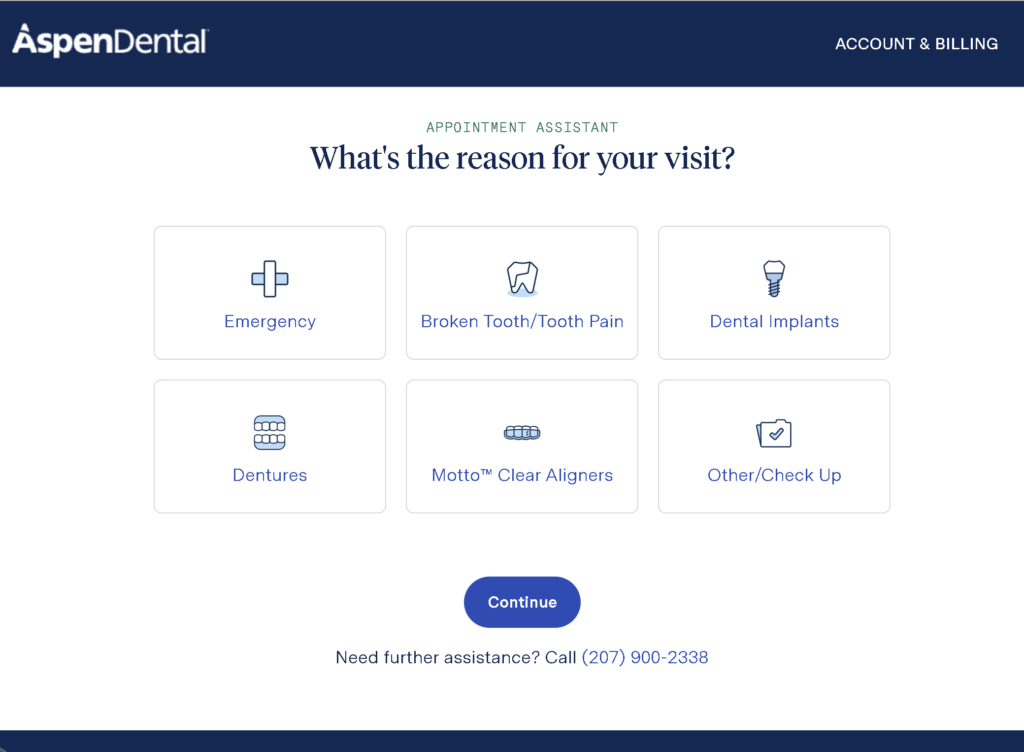
As a first step, reduce the number of steps to complete a booking by doing the following:
- Eliminate irrelevant information requests
- Make forms easy to use and populate
- Optimize appointment forms for mobile
And make sure that your online booking offers a true appointment booking experience. You don’t want your patients submitting a request and then waiting to hear from you. To that end, integrate your online booking with your EHR or PMS to ensure your patients can fully book. If they have to call in to complete a step, you’re only putting up barriers while also increasing patient frustration.
Consider Call Tracking for your Contact Center
Call tracking and analytics software can help you uncover issues that may have historically prevented callers from booking an appointment. Implementing a call tracking and analytics solution can help you improve lead quality and increase conversions and lead volumes.
It can also help identify issues such as:
- Poor staff communication
- Cumbersome or confusing booking process
- Common objections
- Long wait times
With these insights, you can then train your staff to close more leads into booked appointments.
Conclusion
In the End, It’s About Narrowing the Focus and Working Smarter
Successful patient acquisition isn’t about casting the widest net—it’s about precision. The strategies in this guide are designed to help you attract the right patients, not just more leads.
- Optimize what’s already working: Refine conversion signals, call tracking, and bidding strategies to improve lead quality.
- Expand strategically: Test new channels like PMAX, LSAs, and Meta with measured, data-driven experiments before scaling.
- Fine-tune continuously: Marketing success isn’t set-it-and-forget-it. Use structured testing and optimization to stay ahead of shifting consumer behavior.

